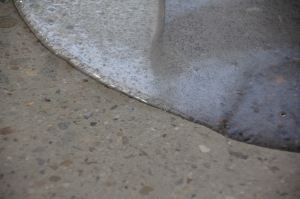Home › Blog › Why coat concrete?
Why coat concrete?
What are concrete coatings?

Concrete coatings come in many forms: thin roll-coat coatings, thick trowel-down coatings, self-level coatings, clear coatings, pigmented
coatings etc.
With such a great variety of concrete coatings available, they’re naturally used to perform a whole host of roles. Protective flooring systems, metallic flooring systems and non-slip
flooring systems are well-known and attract most of the attention, however there are a few more reasons why concrete coatings get used that aren’t
as widely known.
Our top concrete coating tips below talk about three extremely valuable uses for concrete coatings that perhaps don’t get as much
recognition.
Why should concrete be coated?
-
Concrete dust-proofing - The reasons why concrete floors dust vary with age. For new concrete, the biggest source is a
fine, loose by-product of the hardening process called laitance; for older slabs, abrasive traffic is the main problem.
The problem with concrete dust is how fine it is and, therefore, its uncanny ability to get everywhere! It can contaminate and damage all
sorts of valuable things: food, stock, electrical gear...the list goes on. It’s also quite tricky to clean up and very abrasive, which
may cause trouble in other sensitive areas, including human lungs for example. With consequences like these you can see why dust-proofing
with the use of an epoxy concrete sealer is a big reason for coating concrete.
-
Easier to clean - Left in its natural, open state, a concrete floor acts pretty much like a giant sponge; whatever spills
onto the surface will quickly absorb into the slab and be very tricky to remove. This characteristic is bad news on a couple of levels.
Firstly, the “one-two” punch of rapid staining and stubborn removal is a blow to your hopes of maintaining a pristine concrete
floor. Everyone’s seen the dark, dingy garage with oil stains, however the scary part is that it doesn’t need black gunk to look
bad. Just about any liquid will soak into concrete flooring and create a colour difference that’s hard to ignore.
Secondly, by trapping all sorts of grime and moisture, concrete pores provide the perfect breeding ground for bacteria and mould (think
shower bases). This can be a health concern for anyone exposed long enough and clearly unacceptable for food processing facilities,
hospitals and the like.
-
Safety and comfort - With the help of concrete coatings, a floor can play an active role in making life easier and safer.
The most common example is non-slip epoxy flooring, however concrete floor coatings can also improve safety by enhancing visibility and
communicating instructions to workers. Bright line marking and colour coding clearly defining steps, thoroughfares and danger zones are
universal features on workshop floors for that very purpose. The visibility benefits also extend to the quick detection of spills and
other slip hazards. A spill partially soaked up by dirty, dull concrete flooring will be much harder to deal with than one sitting on top of
an impermeable, easy-to-clean surface.
It may come as a surprise to some to hear comfort thrown into this mix as well, however it’s a very real thing. Ask any factory worker
who’s on their feet all day in the middle of winter and they’ll tell you a good warehouse epoxy floor can make a big
difference to the draught chill factor. They’ll also probably tell you that putting down a protective
concrete coating system,
even a plain colour, brightens a workplace considerably.
Take care and keep smiling,
Jack Josephsen
